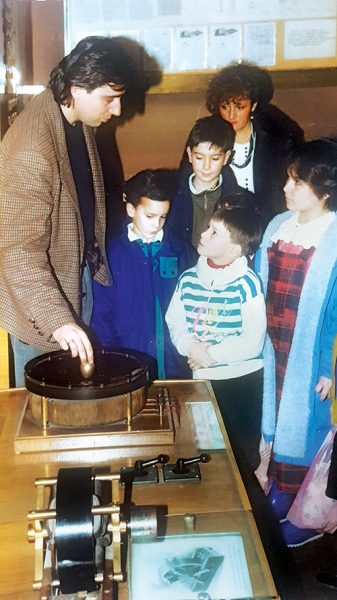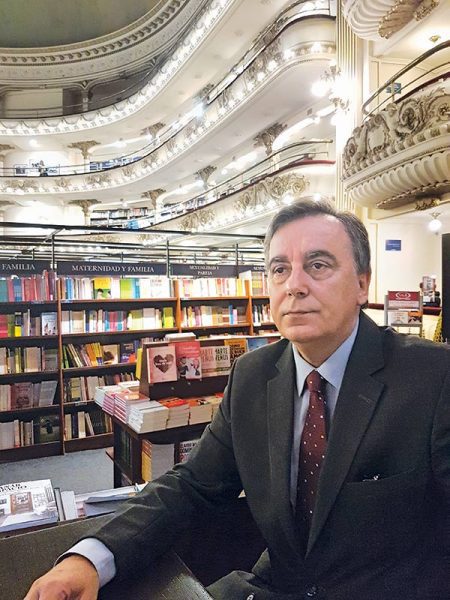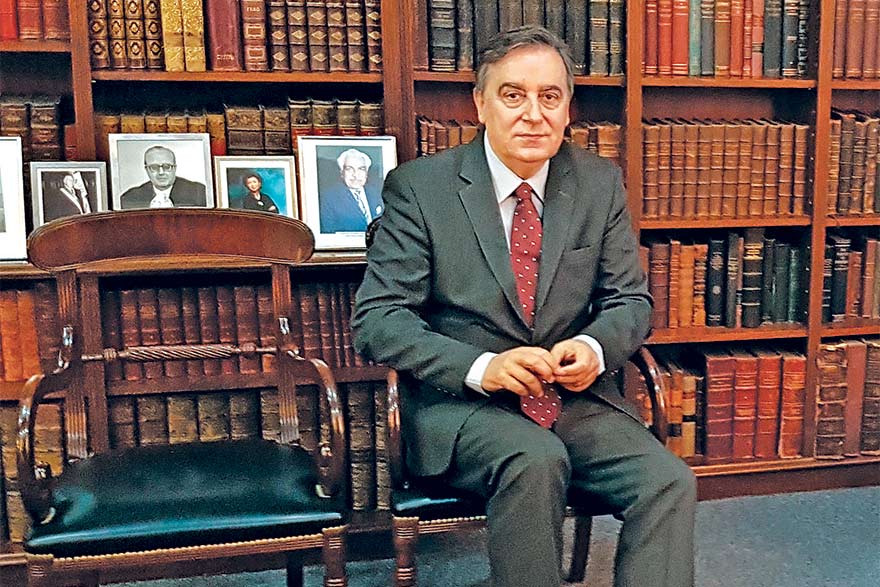Who is Branimir Jovanović, the scientist who has spent more than four decades studying the work of the genius Nikola Tesla? What are the truths and misconceptions when it comes to the inventor from Smiljan and graduate of the Technical High School in Graz? Are we aware of how important the transfer of the knowledge of the insights and ideas that Tesla gathered during his life and the impact of these ideas on the organisation of a truly sustainable society of the future? How many of us are today alerted by Tesla’s statement that this civilisation leads to comfort and security, but does not lead in the direction of true culture?!
Only proper, great admirers dedicate their professional life to one topic, and even rarer to one person. Branimir Jovanović (65) belongs to that group of scientists who direct all of their interests towards one man, one historical figure – Nikola Tesla.
It is difficult to determine when this happened, when Branimir was first attracted to the work of the inventor from Smiljan an untried graduate of the Technical High School in Graz, but he vaguely recalls once visiting the Nikola Tesla Museum during his primary school days:
“I don’t know exactly when that was, but I clearly remember how I started working at the Museum. It was in the summer of 1977, when I was in the third year of my studies at the Faculty of Mechanical Engineering. I was returning from Tašmajdan swimming pool, dressed in shorts and a T-shirt, with flip-flops on my feet and unkempt hair, and near the building where I lived I encountered a classmate from the faculty who told me he was going to the Museum for a job as a demonstrator. He invited me to keep him company and when I remarked that I wasn’t properly dressed he said that it didn’t matter because there were no visits at that time and the curator was a friend of his parents, so he wouldn’t get angry.
To this day I still vividly recall the oblique sunlight falling on the elegant Museum door, and the smell of museum artefacts when we entered. I was surprised when my friend suggested, in the middle of the job interview, that I start working instead of him for a month and that he would replace me later. The Museum building was only a ten-minute walk from the apartment where I lived with my parents, the salary was decent and I happily agreed. For some reason, my friend never mentioned our agreement, he left me to continue working and that month of work as a replacement turned into a life-long career. “
Observing Tesla in the context of Orthodox epistemology became my greatest fascination. That’s because then a man is fascinated not only by Tesla’s personal genius, but also by the genius in his family, in which people like that included his mother and uncle and grandfather and brother, and who knows which other members of his family
Born in Belgrade, where he completed the St. Sava Primary School, the XIV Belgrade Gymnasium High School and the Faculty of Mechanical Engineering, Branimir lived with his parents in Krunska Street (then Proleterskih Brigada), so he spent a good part of his youth at the heart of Vračar. He graduated in the history and philosophy of science at Zagreb Faculty of Philosophy in 1987, then earned his doctorate from the Faculty of Mechanical Engineering in Belgrade sometime later. All of his topics – for his graduate, master’s and doctoral studies – were connected to the works of Nikola Tesla.
He arrived at the Museum in 1977, when he started working as a demonstrator while he was a student, and has remained there – with certain interruptions – until today. He has gone through all positions – from demonstrator, archivist and curator, to senior curator and ultimately director of the Museum. Today he holds the position of assistant director. The married father of Adela, Sofija and Pavle, he is the grandfather of Rastko, Miša and Vanja.
CorD’s interviewee has published dozens of scientific papers, books and studies, but it is certainly worth mentioning the monograph that was published in Cyrillic script in 2001 under the title ‘Tesla – spirit, work, vision’, and republished in a Latin script version by Vulkan in 2014, under the title ‘Tesla’s Wonderful World’. The book has been translated into English and Chinese and represents a synthesis of his many decades of research into Tesla’s personality and work.

When he talks about the upbringing he received at home, Branimir says that it was traditional:
“My parents had a modest high-school education and passed down to my brother and I the ideals of life in the former Yugoslavia, which were reflected in the famous sentence: ‘Son, finish college, get a job and be a man’. Father served on the railways and mother was a housewife. The value system that was nurtured in my family was simple. You should live honourably and honestly, from your own knowledge and work. Mother always told us – ‘children, be good’. I intellectually outgrew my parents relatively quickly and to my provocative question – ‘mum, what does it mean to be good?’ – I didn’t usually receive an answer in words. Mother used examples to show this. She lived a life dedicated to her family and children. The basis for their existence was father’s salary. The entry of a television into the house was a revolution, and it was relatively late when my father managed to buy a car. First was a Russian Zaporizhzhia, and then a beetle that was produced in Sarajevo. That was the pinnacle of my family’s ambitions in a material sense.”
And when did Branimir start getting seriously interested in Nikola Tesla?
It should be known that he graduated from the Faculty of Mechanical Engineering with a degree in aerospace technology and should have dedicated himself to a job as an aeronautical engineer. He had numerous possibilities to do so. Engineers in that profession were in demand at the aircraft factory in Mostar, in Pančevo, at the Military Technical Institute etc. However:
“Another possibility emerged at the Museum itself. Specifically, the secretary of the Museum retired and a job became vacant. I had a strong affiliation with history, art and philosophy, so I told my parents that I would like to work temporarily at the Museum, until I found a job in my profession. I was interested in continuing research into Tesla’s work in mechanical engineering, which I had just begun by writing a dissertation on his contributions to aviation. That was the time immediately after Tito’s death, and there was a change of director. Arriving to head the museum was a professor of the Electrical Engineering Faculty in an honorary role. He didn’t have much time to devote to the work programmes of the museum. The atmosphere was relaxed, working hours weren’t strict and I remember those first few years of working at the museum with great pleasure.”
My conclusion is that the issue of genius was closely related to the issues of character, upbringing, value system and worldview
His day would begin with him entering the Museum’s Archives, selecting one of six hundred boxes of Tesla’s original material — his letters or notes on scientific work — and spending the day in the company of this great genius. He felt like a child in a pastry shop. However, he realised after a few years that he hadn’t managed to memorise most of the things that he’d read. He then began taking systematic notes, in order to create a kind of road map through Tesla’s archive:
“It was at that time that I first heard from an American professor, who came to visit the Museum, that a scientific discipline called the history of science exists in the world and that I should better acquaint myself with that discipline if I wanted to place my research on solid scientific foundations. After a short inquiry, I discovered that in the then Yugoslavia only the Faculty of Philosophy in Zagreb organised postgraduate studies in the history and philosophy of science, and did so at the Inter-university centre in Dubrovnik. I enrolled in the first semester of those studies in 1985, with the idea of concluding by doing a master’s thesis related to Tesla’s research. I see that year as the start of my serious work on Tesla.”

However, his fascination with Nikola Tesla began in his student days, when Branimir worked as a demonstrator at the Museum. His work was related to the exhibition, and initially he didn’t have access to the upstairs spaces where the library and archives were located. As time went by and he gained the trust of the people who ran the Museum, he was allowed to occasionally spend time in the museum library in order to use the literature to expand his knowledge related to the work of demonstrators. The library was formally open to visitors, but was very rarely used: “When I discussed that more than 150,000 original documents were kept in the archives, it was not clear to me why the smartest minds in Serbia (Yugoslavia) didn’t sit in the library and use the rich material that the museum preserves. That was my first fascination. Later, when I gained permanent employment and started my serious scientific research, I was fascinated by the fact that a man who enjoyed a reputation as a genius with an incredible memory, who didn’t need paper and pencil to put his ideas into practise, kept even the most insignificant papers related to his life and work. But certainly the greatest fascination is not related to his work, but to his personality.”
Branimir’s doctoral dissertation was dedicated to the methodology of Tesla’s research work. He considered that, if something important existed in that method, it would be worth researching and passing on that knowledge. In his postgraduate studies he was encouraged to shed light from as many possible positions on all the research of scientific ideas undertaken in the past. Not only from the position of his base profession, but also from the position of history, sociology, philosophy etc.:
Tesla’s ‘foreseeing’ of the future was actually based on the examining of trends of certain social phenomena. He explained the method that he used in his famous technologicalphilosophical study, published in 1900 under the title ‘The problem of increasing human energy’
“When I came to the point in developing my thesis that it was necessary to explain Tesla’s specific creativity in more detail, I was confronted by what were, in my opinion, unconvincing scientific theories that in no way met the criteria of an elementary understanding and interpretation of this specific aspect of Tesla’s personality. Our materialist-orientated science had no fine tools at its disposal to understand spiritual phenomena. My contextual analysis of researching Tesla’s method had until ended with the influence of British and American scientists, but now – based on the advice of a mentor – I began looking at Tesla’s method in the context of his family’s spiritual history and his family heritage and upbringing.
“I realised that understanding not only Tesla’s method, but also his entire personality, would be incomplete without this kind of insight. Observing Tesla in the context of Orthodox epistemology became my greatest fascination. That’s because then a man is fascinated not only by Tesla’s personal genius, but also by the genius in his family, in which people like that included his mother and uncle and grandfather and brother, and who knows which other members of his family. My conclusion is that the issue of genius was closely related to the issues of character, upbringing, value system and worldview. The best thing about it all was that my insights and the level of understanding of my own personality, as well as the personalities of my family and friends and colleagues, improved a lot during that period.”
What is the hardest thing to understand when it comes to Tesla’s discoveries? Why does a certain mystification exist when it comes to Tesla’s discoveries? The closest thing to the truth is that the genius himself partially contributed to that, particularly towards the end of his life. It was then that he made incredible claims that he had discovered new sources of energy and the possibility of a complete solution to the energy needs of mankind. These statements of his provided the basis for an entire series of abuses after his death, when he was credited with discovering machines for using “free energy”, over unity machines (devices that give off more energy than they use) and the like:

“After all the insights and research of his entire documentation, for me there are three possibilities to explain his statements: first, that Tesla – regardless of how much of a genius he was – was mistaken when it came to some of his views and alleged discoveries, which would not be unusual because many great people from the past had misconceptions about certain phenomena; second is that, for some reason, perhaps in an attempt to find sponsors for his research, he deliberately formulated his discoveries in a way that could be interpreted sensationally; and the third and most exciting possibility is that he did indeed have some insights that have remained hidden to our science today. A thorough answer to these questions requires resources, time and a team of dedicated multidisciplinary researchers.”
Many people who admire Tesla’s achievements in the field of physics are ready to say that Tesla foresaw the future. How is it possible to explain to a layman, an inhabitant of the planet Earth, what this is and how Tesla foresaw the future? Mr Jovanović answers as follows:
“Tesla’s ‘foreseeing’ of the future was actually based on the examining of trends of certain social phenomena. He explained the method that he used in his famous technological-philosophical study, published in 1900 under the title ‘The problem of increasing human energy’. Tesla was a pioneer of what is today called social physics or ‘big data analysis’. He visited the New York Central Library every day and in all major languages (English, German, French, Italian) followed, or rather ‘scanned’, the information that interested him. We shouldn’t forget that he was endowed with an unusual memory ability and that he was a genius, which meant that he could process a large amount of data in a short period of time, and thus observe social phenomena from the aspect of analysing the forces acting on them, and particularly from the aspect of inertia. To the eyes of the uninitiated, that seemed almost mystical.”
Many are today ready to interpret Tesla’s special, or supernatural, powers. Branimir sees such interpretations as a social and psychological phenomenon. With the advent of the internet, Tesla became a pop culture phenomenon, a kind of comic book hero who could easily be attributed with fantastic qualities. At the basis of this are many phenomena – from the hidden desire of individuals for sensationalism and greed, to the subconscious desire of the common man for a mythical personality, who solves our accumulated problems heroically, in an incredible and delightful way.
There is one key idea of Tesla related to a solution to the ‘anthropological’ issue of dialogue between the spiritual and scientific elites this civilisation. Tesla defined this as a solution to the spiritual and moral problems of humanity, as a counterweight to its materialistic aspirations
When he came to the Museum as a young man, Branimir was aware that that was the time of Josip Broz Tito’s socialism, where not much was said about Nikola Tesla. Do we in Serbia today have an awareness of the greatness and importance of Nikola Tesla?
“An awareness about the greatness of Tesla exists in Serbia. There is probably no other country in the world where Tesla is so glorified and celebrated. But awareness of Tesla’s importance is still at a very low level even in Serbia. Unfortunately, that awareness doesn’t exist to a sufficient extent even among those who create our science, culture and education. Tesla is the greatest channel of communication with the world that Serbia doesn’t use enough. When it comes to culture, and not just science, there is no other personality in our history, or even our present, who possesses such communication potential.”
This civilisation leads to comfort and security, but doesn’t lead in the direction of true culture – to quote Nikola Tesla. Few people in the world today mention this warning of Tesla’s. On the other hand, many interested people prove that Tesla would certainly have been more celebrated around the world and would have done better in his life if he hadn’t arrived in America from a Balkan province:

“That would certainly have been the case, especially if Tesla’s origins were in the Anglo- Saxon world, which has opportunities for cultural marketing that Serbia doesn’t have. But that isn’t the most important issue. A more important issue is transferring to new generations the knowledge, insights and ideas that Tesla amassed during his life, and the impact of these ideas on the organising of a truly sustainable society in the future.
“There is one key idea of Tesla in this regard that I would like to highlight for the conclusion of this interview. That idea is related to a solution to the ‘anthropological’ issue of dialogue between the spiritual and scientific elites this civilisation.
Tesla defined this as a solution to the spiritual and moral problems of humanity, as a counterweight to its materialistic aspirations. This is the main condition for true sustainability and can be achieved through the development of true culture and true education. This would be a culture that isn’t only identified with art and needs to return to the ancient meaning of ‘dedicated nurturing’, and an education that doesn’t only nurture skills for solving material problems, but rather also those for the development of personality and improving of character.”